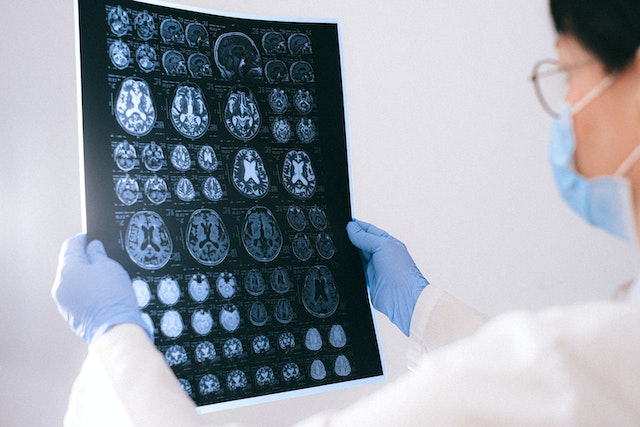
What causes a stroke? There are different types of strokes, but the most common is an ischemic stroke and it is caused by a blockage in one of the blood vessels in the brain.
The brain has a huge oxygen requirement. It is only 2% of your bodyweight, but it uses 15 to 20% of the body’s blood and oxygen supply. The brain’s oxygen supply is so vital that it will go to great lengths to keep the blood flow going in an emergency. It will shunt blood away from extremities, narrow blood vessels, and increase the heart rate to make sure blood still reaches the brain. If our brain loses its oxygen supply, we will lose consciousness quickly.
There are two reasons why the brain needs so much oxygen. Our brains use an enormous amount of energy, and they make this energy by burning glucose from the blood with oxygen to release heat energy and adenosine triphosphate, which is further converted to get the energy. This is called aerobic metabolism. Our muscles can also make energy through anaerobic metabolism, but our brain cannot do that. Without a constant supply of oxygen, it cannot produce energy. The second reason is that the brain cannot store energy. Our muscles are able to store a certain amount of energy, but the brain doesn’t have the capacity to do that, so, with no oxygen supply, it will shut down very quickly.
The blood to the brain doesn’t only supply oxygen, it removes materials and waste from the brain. If the blood supply is shut down, these can build up as well. The oxygen is supplied to the brain through two pairs of arteries that are called the vertebral arteries and the internal carotid arteries. Once they enter the skull they join together into a circle called the Circle of Willis, and branches of blood vessels spread out from this, taking blood to different parts of the brain. The Circle of Willis is possibly a way of overcoming damage and blockage in the brain. If blood vessels become blocked, blood can be rerouted. That can only work to a certain level and the blockages that cause strokes are too much for the system to cope with.
There are two types of strokes: ischemic strokes and hemorrhagic strokes. Ischemic strokes account for 87% of all strokes, so let’s look at those first. An ischemic stroke happens when a blood clot or plaque blocks a blood vessel to the brain and cuts off the blood supply. Plaque builds up in our blood vessels, gradually narrowing them. Plaque is caused when the muscle cells in the walls of arteries multiply to trap cholesterol and fats that have lodged there. They grow over the deposits, forming a cap that can narrow the arteries. If plaque builds up on the arteries that lead to the brain, it can reduce or even cut off the blood supply. This plaque is not very stable and can break up, moving in the blood vessels. If this happens in an artery that leads to the brain, it could become trapped on another area of plaque and cut off the blood supply. If the plaque breaks open, the body will see it as an injury to the blood vessel and send blood platelets to the area to fix it. These platelets will clump together to form a blood clot in order to stop any bleeding in the artery. This blood clot can block off the artery, or it can break off and sail around in the blood until it becomes blocked somewhere else, cutting off the blood supply.
When the blood supply to the brain is cut off, either by plaque or a blood clot, the cells in that part of the brain will begin to die very quickly. Most brain cells cannot last for longer than five minutes without oxygen. The impact of the stroke will depend on where the blockage is. Strokes can be fatal if enough of the brain dies. If the stroke is caught fast enough, there can be some brain damage, but a person’s life can be saved. If the patient can get to a hospital, doctors can give them a tissue plasminogen activator, which breaks up blood clots, freeing the blood supply.
A hemorrhagic stroke is caused when there is a blood leak in the brain. The inside of the skull is a cramped space, and there is nowhere for the brain to move. If a blood vessel in the brain ruptures, blood will flow into the brain and compress areas of the brain, causing damage to those areas of the brain. This can be caused by high blood pressure or accidents. It is less common than an ischemic stroke.
Medical technology has increased and death rates from strokes have come down. However, they still cause a lot of brain damage every year. One of the causes of strokes is obesity and that is a problem that is not going away. And this is what I learned today.
Photo by Anna Shvets: https://www.pexels.com/photo/a-doctor-holding-an-mri-result-of-the-brain-4226219/
Sources
https://www.cdc.gov/stroke/about.htm
https://www.mayoclinic.org/diseases-conditions/stroke/symptoms-causes/syc-20350113
https://www.nhs.uk/conditions/stroke/causes/
https://www.nhlbi.nih.gov/health/stroke/causes
https://www.urmc.rochester.edu/news/story/study-reveals-brains-finely-tuned-system-of-energy-supply
https://faculty.washington.edu/chudler/vessel.html
https://www.pnas.org/doi/10.1073/pnas.172399499
https://www.livestrong.com/article/25939-glucose-provide-energy/
https://teachmeanatomy.info/neuroanatomy/vessels/arterial-supply/
https://en.wikipedia.org/wiki/Circle_of_Willis
https://www.medicalnewstoday.com/articles/circle-of-willis
https://www.medicalnewstoday.com/articles/7624#definition
https://www.hopkinsmedicine.org/health/conditions-and-diseases/atherosclerosis
https://www.nhlbi.nih.gov/health/stroke/treatment
